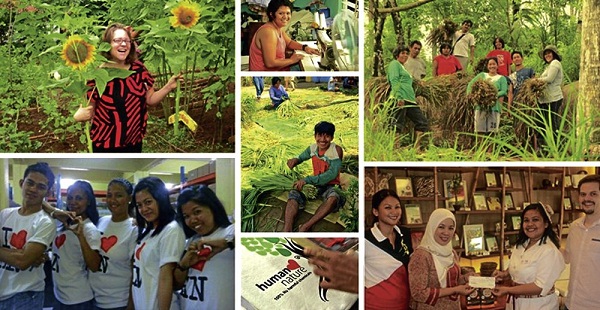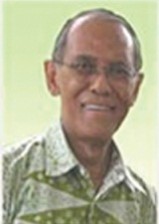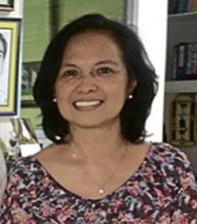Understanding social entrepreneurship

CLOCKWISE from top left: A foreign intern enjoying the blooms at the sunflower farming community of GK Catigan, Davao del Sur; a sewer in GK Payatas Trese; citronella farmers in Barangay Kanapawan in Labo, Camarines Norte; turnover of a check from the profits of Cafe de Sug Sulu Coffee to Jainab Abdulmajid, area coordinator of a community in Sulu; tote bags printed at GK Payatas Trese; Human Nature warehouse staff. Center photo: A farmer in Camarines Norte. Contributed photos
In its broadest sense, social entrepreneurship is about innovative solutions to social problems. In countries like the Philippines where poverty and inequality are worsening despite economic growth, innovative solutions to these problems are not only desired but are also urgent.

ALL PROFITS of Human Nature’s Citronella Bug Spray go back to the community of supplier farmers in Bicol and other communities.
For more than a decade, I have studied the phenomenon of social entrepreneurship in the Philippines and other developing countries in Asia. And what I’ve learned has given me renewed inspiration that it is possible to find sustainable and innovative solutions to the problem of poverty.
Article continues after this advertisementLet me share with you some inspiring stories.
CARD MRI
With a dream to bring sufficiency to the landless rural poor, Aris Alip and 14 other development practitioners started with P20 and a battered typewriter to set up the Center for Agriculture and Rural Development (CARD) in 1986.
Article continues after this advertisementIn 2008, CARD MRI (Mutually Reinforcing Institutions) won the Ramon Magsaysay Award for Public Service “for successfully adapting microfinance in the Philippines, providing self-sustaining and comprehensive services for half a million poor women and their families.”
Today, CARD MRI includes a microfinance institution, a microfinance bank, a bank for small and medium enterprises (SMEs), a mutual benefit association, an insurance agency, a provider of business development services, a provider of information technology solutions and a company promoting generic medicines.
As of November 2012, it was reaching over 1 million poor people with an outstanding loan portfolio of P6.3 billion and a 99-percent repayment rate. Its outreach in terms of life insurance, retirement savings and loan insurance was 7.8 million. Its total asset base was P14.1 billion with more than 7,000 staff members in over 1,400 offices nationwide.
I had the opportunity to visit CARD MRI and personally interact with its founder and managing director, Alip, this January. Asked what he was most proud of, he answered: “We have proven what real empowerment is all about—the ultimate is for our clients to own and manage their financial and community development enterprises.”
He explained that in all CARD institutions, “the poor are part owners or substantial owners, and in the case of the Mutual Benefit Association, it is 100-percent owned by the nanays,” referring to the mothers who comprise the majority of their clients. He pointed out that the way to go in the future was to support rural-based SMEs.
From among the best of its microfinance clients, CARD MRI hopes to assist up to 10 percent of them to develop SMEs. Together with other rural-based small and medium entrepreneurs, CARD MRI also hopes to create a new momentum for wealth creation and employment generation toward nation-building.
Gandang Kalikasan
Anna Meloto-Wilk is cofounder and president of Gandang Kalikasan Inc. for which she received a Global Social Entrepreneur Award under the Schwab Foundation in September 2012.
Established in 2008, Gandang Kalikasan manufactures and markets a line of beauty and personal care products under the brand name, Human Nature. Anna and her team have pioneered in the pursuit of innovative strategies in transforming the lives of the poor as workers and supplier communities of Gandang Kalikasan, while providing consumers with affordable, health-enhancing personal care products from organic and natural ingredients.
With pro-Philippines, propoor and proenvironment as their banner slogan, Anna says “Human Nature traces its roots to Gawad Kalinga (GK), the nationwide movement for nation-building, therefore, everything we do must benefit the country.”
Explaining the group’s propoor policy and practice, Anna continues: “We employ residents of GK communities and provide them fair living wages above minimum, as much as P675 a day plus full benefits and healthcare, to promote dignity of work …. We practice fair trade by paying above-market prices to our community partners and investing in their livelihood expansion. We see the poor as an investment and not as cost. We encourage our people to pay it forward.”
Gandang Kalikasan’s propoor practice is clearly seen in the way it has allocated profits. One of Human Nature’s best-selling products is the Citronella Bug Spray. Initially, all the profits from this product go to farmers in Bicol to fund the expansion of their farms, from 7 to 47 hectares; an integrated extraction facility; public school renovation; healthcare; and insurance for their families.
In the same vein, 100 percent of the profits from its Passion Fruit Hydrating Lipstick have gone to the supplier community, the GK Village Pueblo Antonio in Catigan, Davao del Sur, until such time that it could purchase an extraction facility. This would allow the GK community to become a producer and supplier of passion fruit seed oil, which commands a much higher price and would provide it with a more sustainable and dependable livelihood.
Bina Swadaya
Financial sus
tainability has been a long-standing challenge for nongovernment organizations (NGOs) engaged in community empowerment programs. As grants from public and private sources have become limited, NGOs have innovated their way out of this problem. An exemplary case of an NGO that shifted to a strategy of social entrepreneurship to deal with the challenge of sustainability is Bina Swadaya in Indonesia.
Since its founding in 1967, it has grown into a self-sustaining group of organizations serving more than 100,000 farmers and creatively working to develop and empower their communities. Bina Swadaya has 17 subsidiary companies engaged in ecotourism, agriculture, printing and publishing.
Employing about 1,500 people and providing sustainable livelihoods for many others, these social enterprises generate profits of over $5 million annually, which are used to finance 95 percent of Bina Swadaya’s budget for development work among the poor. Bina Swadaya’s Trubus agri-magazine, one of the 17 subsidiary companies, sells over 70,000 copies per month.
Leading Bina Swadaya’s development and growth is Bambang Ismawan, cofounder and chair. In 1995, Ismawan received the Satya Lancana Development Award, granted by the President of Indonesia for his service in cooperative and economic development.
CARD MRI, Gandang Kalikasan and Swadaya may be seen as different models of social entrepreneurship and as exemplifying different types of social enterprises. But what are social enterprises? How are they different from regular business enterprises or even traditional NGOs?
In a study of what social enterprises meant for development practitioners in Asia, I led an action research covering the Philippines, Indonesia, Thailand and India in 2002-2004 which came up with a general definition.
Definition refined
This was later refined by a succeeding research on Social Enterprises and the Poor (Dacanay, 2012) as a definition relevant to social enterprises in the context of poverty and inequality in developing countries:
“Social enterprises are social mission-driven wealth creating organizations that have a double or triple bottom line (social, financial and/or environmental), explicitly have as principal objective poverty reduction/alleviation or improving the quality of life of specific segments of the poor, and have a distributive enterprise philosophy.”
Three elements
There are three elements to this definition of social enterprises, aspects of which are exemplified by CARD MRI, Gandang Kalikasan and Bina Swadaya:
Firstly, social enterprises are social mission-driven organizations explicitly pursuing poverty reduction and alleviation as primary objective. The poor are engaged not only as workers, clients or suppliers of these social enterprises, but also as partners in social enterprise or value-chain management and in social-enterprise governance.
At their best, the poor become full-fledged owners and decision-makers of social enterprises, and enact roles as change agents for themselves and their community, sector or society.
Secondly, social enterprises are wealth-creating organizations that have a double or triple bottom line (i.e. social, financial and/or environmental). Just like business or private enterprises, and unlike the traditional NGOs that are dependent on grants or public subsidies—or wealth created somewhere else—social enterprises are engaged in the production and provision, and sale of goods and services.
However, unlike business or private enterprises that principally produce/provide and sell goods and services to create profit for shareholders, social enterprises do so with the objective of financial sustainability. They create wealth to partially or fully cover their operations and to invest in other activities related to their social mission. Their financial bottom line plays a supportive role to their social bottom line.
Thirdly, social enterprises have a distributive enterprise philosophy. They create social and economic value that accrue to the poor as primary stakeholders. Unlike in a business or private enterprise where wages paid to the poor are considered financial costs to be minimized, these are considered social benefits for primary stakeholders that need to be optimized.
Moreover, the distributive philosophy is expressed in the surplus or profits that accrue to the poor as dividends and are reinvested in the enterprise to sustain the fulfillment of its social mission or in activities that benefit and assist the poor.
PH scene
I did a rapid appraisal using secondary data and interviews with key informants to establish a general profile of social enterprises in the country in 2007 (Dacanay, 2007). The rapid appraisal came up with an informed estimate of 30,000 social enterprises.
The biggest segment are cooperatives registered with the Cooperative Development Authority. Outside of cooperatives, social enterprises usually register under the Securities and Exchange Commission as nonstock, nonprofit corporations and/or as stock for profit corporations.
On Feb. 16, 2012, leaders of social enterprises and major networks and resource institutions supporting them came together to establish the Poverty Reduction through Social Entrepreneurship (Present) Coalition.
Magna Carta
The coalition united on pushing for a bill called the Poverty Reduction through Social Entrepreneurship Act or the Magna Carta for Social Enterprises. The measure is meant to recognize, support and incentivize social enterprises serving the poor as major partners in poverty reduction.
The bill envisions a process of qualification for social enterprises serving the poor as stakeholders. Those qualified shall then have the right to financial and program support, preferential rights in government procurement and tax exemptions or incentives.
Among the important provisions proposed which try to address the infirmities of current policies affecting social enterprises are: the setting up of Special Credit Windows for social enterprises that could provide noncollateralized loans supported by a Guarantee Fund Pool; a Social Enterprise Development Fund that would ensure resources for capacity development; and the establishment of an insurance system for social enterprises affected by natural calamities.
Program support shall include Social Enterprise Research and Development as well as Social Enterprise Marketing Infrastructure Development.
The bill on Poverty Reduction Through Social Entrepreneurship codifies an ecosystem conducive to the growth of social enterprises as dominant players in a vibrant SME sector in the country. A government playing a developmental role in partnership with a proactive and innovative social-enterprise sector may just produce the elusive outcome of empowering a significant percentage of the poor and substantively reducing poverty in the country.
(Marie Lisa Dacanay, Ph.D., is founding president of the Institute for Social Entrepreneurship in Asia. She was associate professor and guru of the Master in Entrepreneurship for Social and Development Entrepreneurs at the Asian Institute of Management from 2001 to 2007. She has been the lead faculty for the Master in Public Management [Social Entrepreneurship Track] at the Ateneo School of Government since 2011.)



















